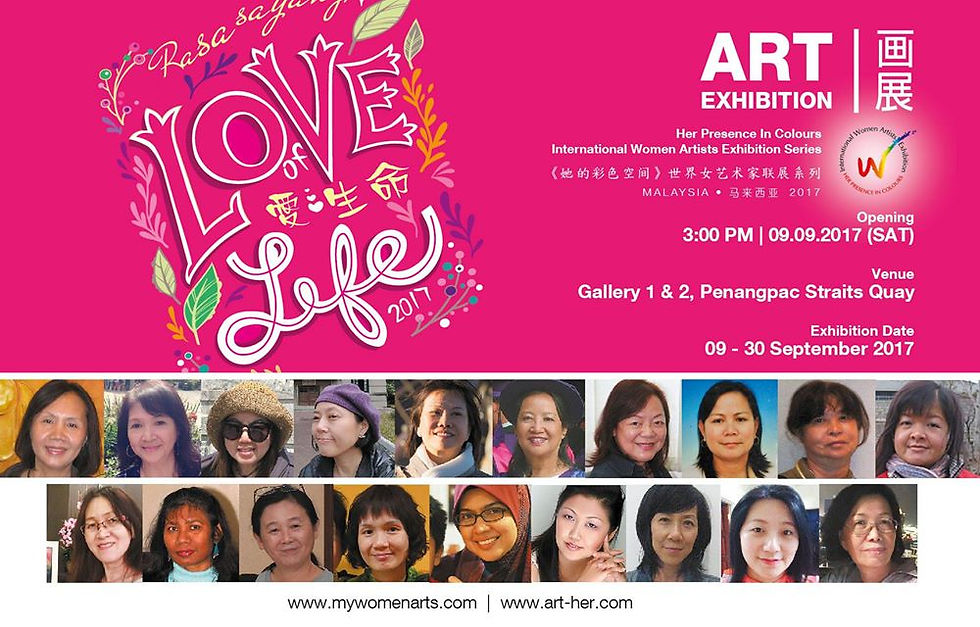Love is Life
- Dr. Kris See
- Sep 10, 2017
- 3 min read
Message to INWAA-MALAYSIA
Beloved friends and members of International Women Artists Association-Malaysia,
As a medical doctor and scientist, I have always marvel about the beauty of life and her processes. “God does not play dice”, remarked arguably the greatest scientist of modern-era, Albert Einstein. Yet medicine is most often than not, a science of uncertainty and an art of probability. In ancient times, a great physicians, often are accomplished artists, notably Hippocrates, William Osler, Harvey Cushing and the list goes on and on.
Studying art with the eye of a physician has allow modern day scientists to gain insights and proposed that perhaps van Gogh was the victim of a rare congenital metabolic disorder. This was done by studying the paintings of van Gogh. Some rheumatologists have tried to use art to understand when certain arthritic diseases may first have penetrated the European population on a wide scale, as genes predisposing people to the disease began to spread. They note that rheumatoid arthritis, a genetically linked disease, is not shown in European painting before 1800 and that therefore the illness may have been rare before that point. Whatever form it takes, doctors and art historians alike say that giving a medical spin to art can provide insight into the development of an artist's work or the prevalence of certain diseases in history.
Arts and medicine were always connected: Ars Medicinae, “The Art of Healing.” Due to the rapid development of technology in the last 100 years, our attention was drawn to the physical realm, and we lost our connection with the deep and powerful mystery of our consciousness. Re-integrating arts and medicine can restore that connection.
The power of our minds and our thoughts are biologically unexplainable in the full capacity they deserve. Our thoughts — positive or negative — are what trigger our brains to release the neurotransmitters that affect mood and health.
Neuroimmunology teaches us that extensive bi-directional communication takes place between the nervous and the immune systems in both health and disease. In a simplified way: If ARTS affect emotions, and EMOTIONS affect health then arts affect HEALTH.
Medicine is really the business of healing. Often, we don’t question the existence of hospitals, because they take care of our bodies. We don’t question the existence of museums, concert halls or arts in other forms, because that’s how we express our emotions and address the needs of our mind and spirit. If humans comprise “body, mind, and spirit,” then why do we question the coexistence of arts and medicine? Why would it be so unexpected to see well-curated art on the walls of a hospital or hear beautiful live music in the waiting areas?
The same artwork that you might see in a gallery or at the exhibition radiates completely different energy when you interact with it in a hospital. In places where people come to heal, different communication channels are open.
Art is sometimes most needed where you don’t expect to find it. Hospitals are places where joy and sorrow meet, where people quickly reset values, and where human existence is peeled off layers of superficiality. This is what makes it so pure and essential.
Medicine and technology might change the time when we arrive at the end of our destinations, but arts will change our perception of that time. In sickness, when the passage of time becomes more palpable, time becomes a precious gift — and the way we perceive it becomes even more important.
“Love of Life”, this theme could not be more suitable than to brings out the interconnectedness of love and living, of arts and medicine. I wish to congratulate INWAA-MALAYSIA for successfully organizing this exhibition, for bringing together the most creative and passionate women artists under one roof and exhibiting their works for a month. Being unofficially dubbed the cultural city of Malaysia, Penang offers all the right ingredients to be the destination of hosting.
Last but not least, please allow me to conclude by quoting one of the most inspiring artists of the 15th century, Leonardo da Vinci who said,
“Painting is poetry that is seen rather than felt, and poetry is painting that is felt rather than seen.”
May I invite all friends to feel and enjoy the beautiful poetry on canvas presented by talented and creative artists.
It is with deepest appreication and great honour for me to be able to pen my thoughts here.
Yours truly,
Dr. Kris See
Osel Group
10/08/2017





Comments